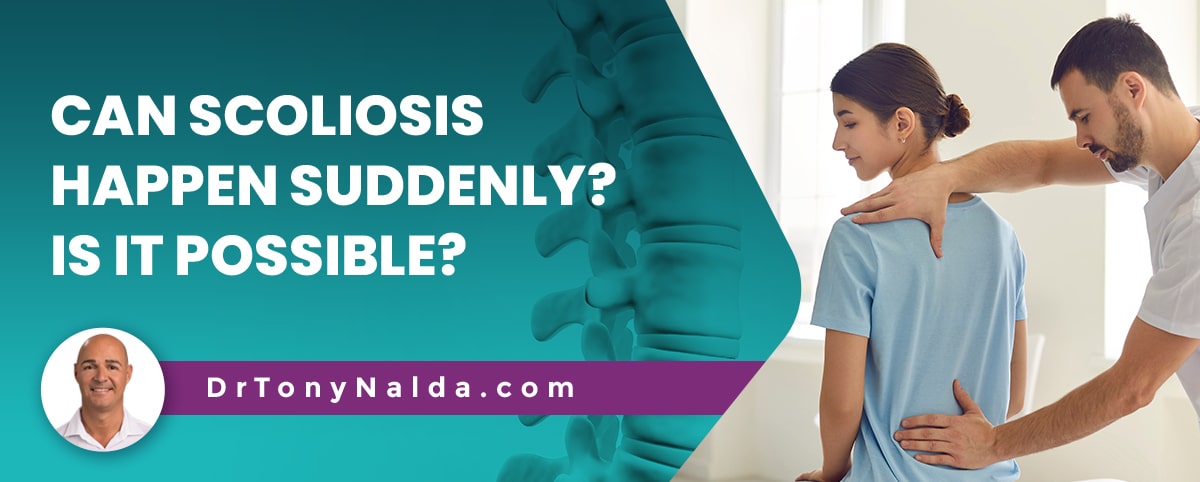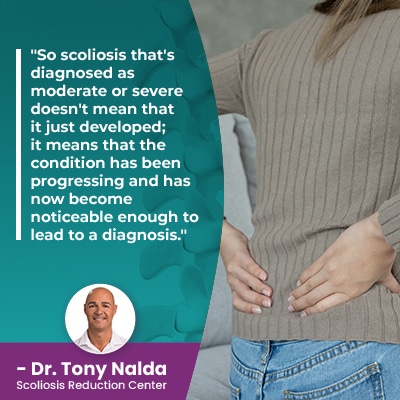Can Scoliosis Happen Suddenly? Is It Possible?

Despite the fact that scoliosis has been around since ancient times, it is still somewhat of a mysterious condition. Most cases of scoliosis aren't associated with known causes, and in the condition's early stage, its effects can be subtle and difficult to detect. Continue reading to learn more about the condition's early signs as this awareness can lead to early detection, which is associated with treatment success.
While it can feel like scoliosis happens suddenly because its effects can suddenly become noticeable, this is not the case. Scoliosis is progressive and ranges widely from mild to very severe; oftentimes, it's not until a certain amount of progression has occurred that condition-effects become overt.
Understanding how scoliosis affects the body is important when it comes to how it develops and progresses, so let's start there.
Table of Contents
How Does Scoliosis Develop?
Scoliosis involves the development of an unnatural sideways spinal curve, and scoliosis is a 3-dimensional condition because it doesn't just cause the spine to bend unnaturally to the side, but also twist unnaturally.
The spine's natural curves make it stronger, more flexible, and better able to handle mechanical stress, and the development of an unnatural spinal curve can disrupt the biomechanics of the entire spine.
Now, when addressing how a condition develops, the issue is causation: what causes a condition's initial onset.
With scoliosis, approximately 80 percent of known diagnosed cases are classified as idiopathic scoliosis, which means not clearly associated with a single-known cause, and the remaining 20 percent are associated with known causes: neuromuscular scoliosis, degenerative scoliosis, and congenital scoliosis.
Scoliosis affects all ages, and while it's more often diagnosed in children, adult scoliosis is prevalent too, and in many cases of adult scoliosis diagnosed, they have had the condition for years, but were unaware until scoliosis symptoms increased and led to a diagnosis.
A diagnosis of scoliosis can be reached through a physical exam that includes taking the patient's family history, observing a patient's posture, gait, and ordering x rays to determine a patient's Cobb angle and really see what's happening in and around the spine.
So in order to address how scoliosis develops, let's take a look at the different condition types and their causes.
How Does Adolescent Idiopathic Scoliosis Develop?
Adolescent idiopathic scoliosis is the condition's most-prevalent type, and it's diagnosed in adolescents between the ages of 10 and 18.
Now, in this type, we don't know what triggers its initial onset, but we do understand what triggers its progression: growth and development.
As adolescents are in, or are entering into, the stage of puberty, they are at risk for rapid-phase progression due to rapid and unpredictable growth spurts.
Now, while there are never treatment guarantees, with scoliosis that's detected early, and responded to with a proactive treatment plan, there are fewer limits to what can be achieved, but early detection in children isn't always easy.
Scoliosis doesn't become a compressive condition until adulthood has been reached, and it's compression of the spine and its surrounding nerves and muscles that causes the majority of condition-related pain; back pain, leg pain, nerve pain, etc.
So for adolescents, the condition isn't commonly painful, particularly when mild, and mild scoliosis isn't known to cause functional deficits; the main effect of scoliosis in adolescents is postural deviation, and even those changes can be subtle, and it's often not until mild scoliosis has progressed and become moderate that its effects become noticeable.
 In addition to uneven shoulders and hips, changes to gait, balance, and coordination are common.
In addition to uneven shoulders and hips, changes to gait, balance, and coordination are common.
So scoliosis that's diagnosed as moderate or severe doesn't mean that it just developed; it means that the condition has been progressing and has now become noticeable enough to lead to a diagnosis.
Here at the Scoliosis Reduction Center, this is the reason most of my adolescent idiopathic scoliosis patients have moderate scoliosis, not because it developed as moderate scoliosis, but because it progressed from mild, and progression has made the condition's effects noticeable.
How Does Neuromuscular Scoliosis Develop?
Cases of neuromuscular scoliosis are caused by the presence of a larger neuromuscular condition such as spina bifida, cerebral palsy, or muscular dystrophy, and these cases are considered atypical.
So neuromuscular scoliosis develops as a secondary complication of another medical condition, and while it's not guaranteed that people with neuromuscular conditions will develop scoliosis, it is a common complication.
So neuromuscular scoliosis also doesn't tend to develop suddenly, but over time as the larger neuromuscular condition disrupts the connection between the brain and the muscles and/or connective tissues supporting the spine.
When it comes to treating neuromuscular scoliosis, the underlying neuromuscular condition is the guiding force of treatment as the underlying cause of the scoliosis progression and development.
How Does Degenerative Scoliosis Develop?
After adult idiopathic scoliosis, degenerative scoliosis is the next most common form of adult scoliosis, commonly diagnosed in older adults.
Degenerative scoliosis also doesn't develop suddenly, but slowly over time as natural age-related spinal degeneration is the cause.
Degenerative scoliosis is also known as de novo scoliosis, meaning there is no prior history with the condition, unlike cases of idiopathic scoliosis in adults.
The spine consists of vertebrae (bones) stacked on top of one another in a straight and neutral alignment, and adjacent vertebrae are separated by an intervertebral disc, and in most cases of degenerative scoliosis, degenerative disc disease is a contributing factor.
 The spinal discs provide cushioning between vertebrae to prevent friction during movement, give the spine structure (vertebrae attach to the disc in between), combine forces to facilitate flexibility, and act as the spine's shock absorbers.
The spinal discs provide cushioning between vertebrae to prevent friction during movement, give the spine structure (vertebrae attach to the disc in between), combine forces to facilitate flexibility, and act as the spine's shock absorbers.
In light of the discs' many important roles, it makes sense that disc degeneration is usually the first stage of a number of degenerative spinal conditions.
So when adults are diagnosed with scoliosis, it's often because they were adolescents with adolescent idiopathic scoliosis who didn't receive a diagnosis or treatment during adolescence, their scoliosis progressing into adulthood when it becomes compressive, painful; it's back and radiating pain that brings most adults in for a diagnosis and treatment.
And in cases of degenerative scoliosis, we're talking about how adults develop scoliosis slowly due to degenerative changes that take place over time and/or the cumulative effect of certain lifestyle choices.
How Does Congenital Scoliosis Develop?
Congenital scoliosis are rare cases affecting approximately 1 in 10,000, and babies are born with the condition as it's caused by a malformed spine that develops in utero.
Patients with congenital scoliosis have to be monitored and assessed comprehensively because it's not uncommon for these patients to have other parts and systems within their bodies that are also malformed.
So congenital scoliosis develops as a baby's spine is developing; common malformations can include vertebrae fusing into one solid bone instead of forming into separate and distinct vertebral bodies as they should be, and or one or more vertebral bodies being misshapen and more triangular, than rectangular, in shape.
It's not uncommon for congenital scoliosis to go unnoticed until growth spurts cause progression and the condition becomes more noticeable.
Conclusion
So can scoliosis happen suddenly? The more appropriate question is can scoliosis get worse suddenly, and the answer is that as a progressive condition that's triggered by growth, a rapid and unpredictable growth spurt can cause rapid progression.
As scoliosis progresses, the size of the spine's abnormal curvature is increasing, as are the condition's uneven forces, and their effects.
It's rare that a person will be diagnosed with scoliosis at the time of its onset because when mild, its effects can be subtle and difficult for anyone, other than a specialist trained in what to look for, to notice.
Once scoliosis is diagnosed, patients need to understand that where their scoliosis is at the time of diagnosis is not indicative of where it will stay, particularly if left untreated, or not treated proactively.
Scoliosis tends to develop over time and progress with growth and development, and a common scenario is that scoliosis is left undiagnosed in children and adolescents, and it's not noticed until it becomes a compressive condition once skeletal maturity has been reached; the lengthening motion of a growing spine counteracts the compressive force of the scoliotic curve.
Scoliosis cases that are diagnosed as mild are going to be the most responsive to treatment because curve progression increases spinal rigidity, making it less responsive to treatment, and physical therapy/core strengthening exercises are a facet of treatment that can be difficult for most patients with significant spinal rigidity to perform.
Here at the Scoliosis Reduction Center, I believe the best time to start scoliosis treatment is always now because as a progressive condition, it's far more effective to proactively work towards preventing progression and potential complications, than it is to attempt to reverse it after it's occurred.
The fact that I've been treating my scoliosis patients with non-operative treatment for over 20 years shows that good outcomes are possible without scoliosis surgery; spinal surgery is costly, invasive, and can come with some serious potential side effects, complications, and significant risk.
Through a conservative chiropractic-centered treatment approach that combines multiple different types of condition-specific forms of treatment, conditions can be impacted on every level, progression can be managed, and the need for invasive surgical treatment in the future can be avoided.
Dr. Tony Nalda
DOCTOR OF CHIROPRACTIC
After receiving an undergraduate degree in psychology and his Doctorate of Chiropractic from Life University, Dr. Nalda settled in Celebration, Florida and proceeded to build one of Central Florida’s most successful chiropractic clinics.
His experience with patients suffering from scoliosis, and the confusion and frustration they faced, led him to seek a specialty in scoliosis care. In 2006 he completed his Intensive Care Certification from CLEAR Institute, a leading scoliosis educational and certification center.
About Dr. Tony Nalda
 Ready to explore scoliosis treatment? Contact Us Now
Ready to explore scoliosis treatment? Contact Us Now





